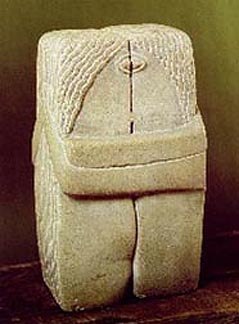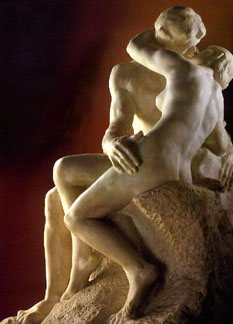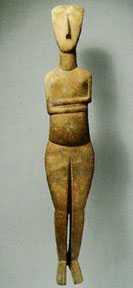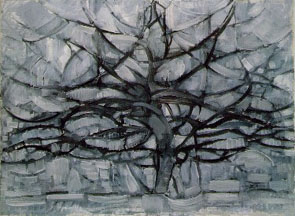.
Art and The Aesthetics of Form
What Has "Beauty" Got to Do With
It?
"Beauty",as they say, is in the eye of the beholder. What is
beautiful to an artist of ancient Greece is very different from the beauty
perceived by an indiginous African. Picasso's sense of beauty was influenced
by the African aesthetic, but many people from his own culture are divided
as to whether they find his work "beautiful". What role does beauty
play in your appreciation of art?
How Does Fame Of
An Artist Affect Appreciation?

Michelangelo?? |

Polish Rider by Rembrandt??
|
Once aware that the creator of a work of art is one of the famed masters,
our appreciation of that artwork is likely to shift. So it is true when
a work that is assumed to be of a master is found out to be by the hands
of his apprentices or a fraudulent copy. How does the interpretation of
who creates a work of art factor into its inherent value?
The Aesthetic Experience

An "aesthetic experience" is one of charged awareness. It is looking
beyond the obvious and experiencing a thing or event on an emotional level.
It can be activated by an experience with the natural world, the contemplation
of forms (including but not limited to art),or a journey into the world
of the imagination. It can be stimulated by something as simple as enjoying
a good meal or as complex as a life-changing event.
Art and Reality: The Aesthetics of
Form
Art may imitate the "real world" (the world revealed to our senses),
or represent an inventive interpretation of what we see.
Abstract - forms which depict the essence of an object through
simplification or distortion.
|
Representational- resembles forms in a manner similar
to how the senses perceive them (naturalistic). |
| Trompe-L'oeil - an artwork which is so focused on
realism that it can "fool the eye". |
Non-Representational - bears little resemblance to
forms within the natural world, instead presenting only the visual elements
of line, shape, color, form, and texture, etc. (non-objective). |
| The above images show the evolution of style of the Dutch artist, Piet
Mondrian. He begins with representational art and moves toward abstraction,
and then to complete abstraction of form til he has simplified his art
to the restrictive use of lines, geometric shapes and bold colors. |
Jackson Pollock (1912-1956) was an abstract expressionist painter known
for his "drip and pour paintings". His works are a perfect example
of non-representational art in that they do not seek to represent any particular
natural forms that we would be able to recognize. He felt that his paintings
were an enactment of nature instead of a picture (or representation) of it.
He sought to capture the rhythm of nature flowing through him by getting into
a trance-like state while painting.
Form and Content

Constantin Brancusi, The Kiss, 1912
|

Auguste Rodin, The Kiss, 1886 |
Consider the sculptures above. What is the subject of each? How
do their forms differ? How does this difference influence the content of the works?
| Form - the sum total of how the elements of art contribute to
how an artwork looks. It includes the media (materials used), the style,
and the elements of its composition. |
Content - the message or meaning communicated by a work of art.
It is the subject of what the artist is portraying as well as the story
and feelings portrayed. |
| To get a clearer idea of how form influences content, it is helpful
to analyze the visual elements of form (describing types of lines,
shapes, etc), and then to realize how those forms create meaning.
Here are some particularly expressive examples: |
 Kathe Kollwitz(German), Death
and the Woman
Kathe Kollwitz(German), Death
and the Woman
|
 Gustav Klimt (Austrian), Death and Life
Gustav Klimt (Austrian), Death and Life |
 Vincent Van Gogh (Dutch), Starry Night
Vincent Van Gogh (Dutch), Starry Night |
All of the above are examples of different types of expressionism,
a style of art which focuses on emotion as its main content.
Artistic Style - characteristics which we can identify
as constant, recurring or coherent between different artworks. Artistic
style can be identified with a whole artistic culture (Classical Roman,
the Song Dynasty in China), with a specific place and time (the early
Renaissance in Florence), with a specific group of artists (the Impressionists
of Paris), or even with the chronological changes of style of a specific
artist (Picasso's Blue period, Rose period, and Cubist period).
Iconography:
Art and Symbols

Jan Van Eych, Arnolfini Wedding |

Albrecht Durer, The Knight, Death, and the Devil |
| Iconography - the story depicted in a work of art, as well
as the symbolism and conventions attached to those images by a particular
religion or culture. |

Robin Urton, The Seer
Iconography is not related only to artists of the past. Many contemporary artists utilize iconic images in their works also. The example above is from the works of the webmaster, whose works are featured in the root pages of this site.
|























